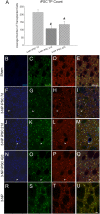Intrastriatal transplantation of adenovirus-generated induced pluripotent stem cells for treating neuropathological and functional deficits in a rodent model of Huntington's disease
- PMID: 24657963
- PMCID: PMC4006485
- DOI: 10.5966/sctm.2013-0151
Intrastriatal transplantation of adenovirus-generated induced pluripotent stem cells for treating neuropathological and functional deficits in a rodent model of Huntington's disease
Abstract
Induced pluripotent stem cells (iPSCs) show considerable promise for cell replacement therapies for Huntington's disease (HD). Our laboratory has demonstrated that tail-tip fibroblasts, reprogrammed into iPSCs via two adenoviruses, can survive and differentiate into neuronal lineages following transplantation into healthy adult rats. However, the ability of these cells to survive, differentiate, and restore function in a damaged brain is unknown. To this end, adult rats received a regimen of 3-nitropropionic acid (3-NP) to induce behavioral and neuropathological deficits that resemble HD. At 7, 21, and 42 days after the initiation of 3-NP or vehicle, the rats received intrastriatal bilateral transplantation of iPSCs. All rats that received 3-NP and vehicle treatment displayed significant motor impairment, whereas those that received iPSC transplantation after 3-NP treatment had preserved motor function. Histological analysis of the brains of these rats revealed significant decreases in optical densitometric measures in the striatum, lateral ventricle enlargement, as well as an increase in striosome size in all rats receiving 3-NP when compared with sham rats. The 3-NP-treated rats given transplants of iPSCs in the 7- or 21-day groups did not exhibit these deficits. Transplantation of iPSCs at the late-stage (42-day) time point did not protect against the 3-NP-induced neuropathology, despite preserving motor function. Transplanted iPSCs were found to survive and differentiate into region-specific neurons in the striatum of 3-NP rats, at all transplantation time points. Taken together, these results suggest that transplantation of adenovirus-generated iPSCs may provide a potential avenue for therapeutic treatment of HD.
Keywords: 3-Nitropropionic acid; Adenovirus; Huntington’s disease; Stem cell; Transplantation; iPSC.
Figures







Similar articles
-
Survival and differentiation of adenovirus-generated induced pluripotent stem cells transplanted into the rat striatum.Cell Transplant. 2014;23(11):1407-23. doi: 10.3727/096368913X670958. Epub 2013 Jul 22. Cell Transplant. 2014. PMID: 23879897
-
Mesenchymal stem cell transplantation and DMEM administration in a 3NP rat model of Huntington's disease: morphological and behavioral outcomes.Behav Brain Res. 2011 Mar 1;217(2):369-78. doi: 10.1016/j.bbr.2010.11.006. Epub 2010 Nov 9. Behav Brain Res. 2011. PMID: 21070819
-
Transplantation of induced pluripotent stem cells improves functional recovery in Huntington's disease rat model.PLoS One. 2014 Jul 23;9(7):e101185. doi: 10.1371/journal.pone.0101185. eCollection 2014. PLoS One. 2014. PMID: 25054283 Free PMC article.
-
Induced Pluripotent Stem Cells in Huntington's Disease: Disease Modeling and the Potential for Cell-Based Therapy.Mol Neurobiol. 2016 Dec;53(10):6698-6708. doi: 10.1007/s12035-015-9601-8. Epub 2015 Dec 10. Mol Neurobiol. 2016. PMID: 26659595 Free PMC article. Review.
-
Modeling Huntington's disease with induced pluripotent stem cells.Mol Cell Neurosci. 2013 Sep;56:50-64. doi: 10.1016/j.mcn.2013.02.005. Epub 2013 Feb 28. Mol Cell Neurosci. 2013. PMID: 23459227 Free PMC article. Review.
Cited by
-
Cell-Based Delivery Approaches for DNA-Binding Domains to the Central Nervous System.Curr Neuropharmacol. 2021;19(12):2125-2140. doi: 10.2174/1570159X19666210517144044. Curr Neuropharmacol. 2021. PMID: 33998992 Free PMC article. Review.
-
Importance of being Nernst: Synaptic activity and functional relevance in stem cell-derived neurons.World J Stem Cells. 2015 Jul 26;7(6):899-921. doi: 10.4252/wjsc.v7.i6.899. World J Stem Cells. 2015. PMID: 26240679 Free PMC article. Review.
-
Concise Review: Towards the Clinical Translation of Induced Pluripotent Stem Cell-Derived Blood Cells-Ready for Take-Off.Stem Cells Transl Med. 2019 Apr;8(4):332-339. doi: 10.1002/sctm.18-0134. Epub 2018 Dec 26. Stem Cells Transl Med. 2019. PMID: 30585439 Free PMC article. Review.
-
Use of Genetically Altered Stem Cells for the Treatment of Huntington's Disease.Brain Sci. 2014 Mar 24;4(1):202-19. doi: 10.3390/brainsci4010202. Brain Sci. 2014. PMID: 24961705 Free PMC article.
-
Genetics, Mechanisms, and Therapeutic Progress in Polyglutamine Spinocerebellar Ataxias.Neurotherapeutics. 2019 Apr;16(2):263-286. doi: 10.1007/s13311-018-00696-y. Neurotherapeutics. 2019. PMID: 30607747 Free PMC article. Review.
References
-
- The Huntington’s Disease Collaborative Research Group A novel gene containing a trinucleotide repeat that is expanded and unstable on Huntington’s disease chromosomes. Cell. 1993;72:971–983. - PubMed
-
- Estrada Sánchez AM, Mejía-Toiber J, Massieu L. Excitotoxic neuronal death and the pathogenesis of Huntington’s disease. Arch Med Res. 2008;39:265–276. - PubMed
-
- Bachoud-Lévi A-C. Neural grafts in Huntington’s disease: Viability after 10 years. Lancet Neurol. 2009;8:979–981. - PubMed
Publication types
MeSH terms
Substances
LinkOut - more resources
Full Text Sources
Other Literature Sources
Medical
Miscellaneous

